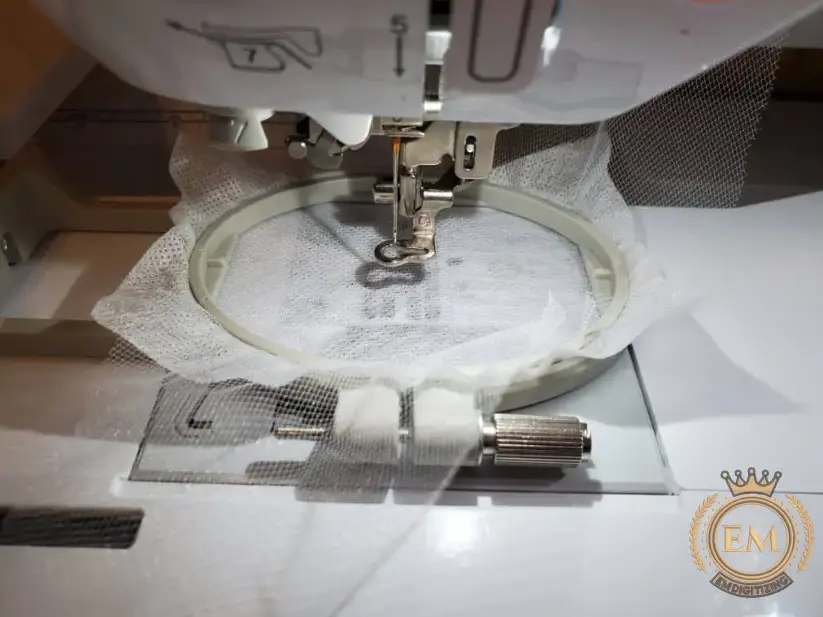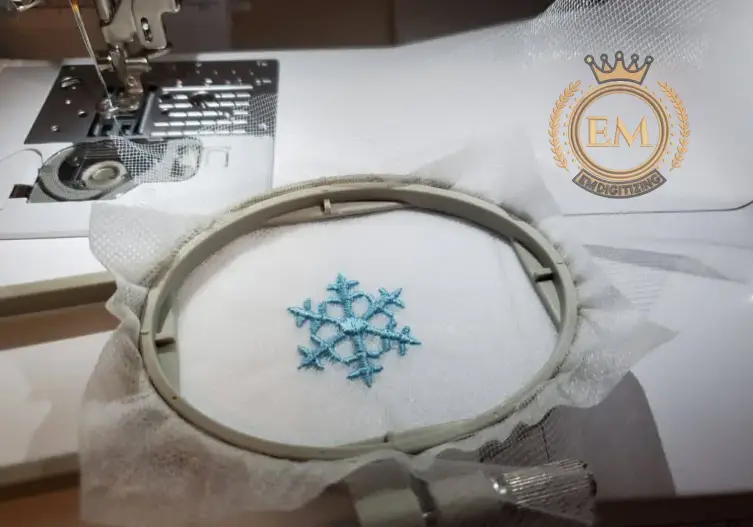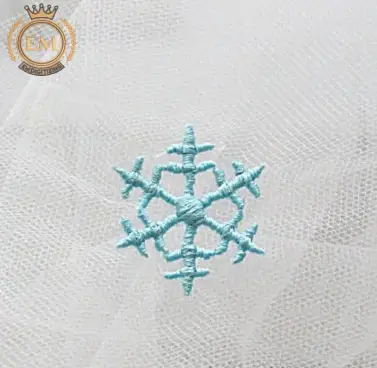
Tulle is a type of material that I don’t use very often. My girls are past the age of tutus and princesses so I don’t really think about it. But tulle is actually an adaptable material for machine embroidery. It can act as a stabilizer and enhance an embroidered or appliqued item. Or you can actually embroider on tulle itself. So, here’s how to embroider on tulle and some examples of how you can use tulle in your machine embroidery projects.
What is Tulle?
Never heard of tulle? This is the material used to make ballet tutus. It is actually a type of mesh although the tulle has holes larger than the mesh. You can buy the tool at the yard or at any fabric store or online on a 6″ wide spool.
Embroidery Digitizing Services
Why would you want to embroider on Tulle?
Tulle has an exceptional quality that makes it a popular choice for everything from princess dresses to bridal and prom dresses. Embroider on tulle looks luxurious which is why you usually see it in formal wear and dress wear.
The tool is also stiff, so you can fold it together to create volume. This is why tutus are so flawed. Often dresses are made with tulle as an underlayer to give them a little more oomph.
The tool is also semi-transparent, so it is often layered with other materials. When you put it on top of another garment, you can see the garment underneath. Of course, if you want to make something really edgy, you can strategically apply or embroider areas of the tulle to cover up patches of skin, then let the skin show through the tulle.
Why is it difficult to embroider on Tulle?
The tool presents a challenge for machine embroidery because the material is so light and can tear so easily. It’s also very porous so it doesn’t give the embroidery much to “cut”. So, for the stitches to stay, you need to stabilize the tool with a material that can offer stability while you sew, then disappear when you’re done.
Tulle also tends to gather so you need to keep it in place as you embroider on Tulle. Pinning it in place is not an option as the material is too porous to hold the pins. Also, pins can cause it to crack.
Materials used to Embroider on Tulle
Here are some materials used to embroider on Tulle.
- Embroidery hoop, embroidery machine, and scissors
- Trolls
- Stabilizer: A washable stabilizer (not a water-soluble topping that is sticky and film-like).
- Needle: I used a 75/11 Schmitz embroidery needle.
- Thread: I used 40 wt polyester embroidery thread for the top thread and white pre-wound 60 wt thread for the bobbin. Of course, you want to match your bobbin and top threads.)
The best stabilizer for Tulle
Since tulle is transparent, the best stabilizer used to embroider on tulle is a wash-away stabilizer.
Using a cutaway or no-show mesh stabilizer is a bad idea because the stabilizer will still be attached to the tulle after embroidery. And when the tearaway stabilizer is missing, it won’t work well because tearing it can damage the delicate fabric and stitches.
Choosing the Right Tulle During Embroider on Tulle
Tulle is a delicate, sheer, flowing net-like fabric with small holes. It is see-through and comes in a myriad of colors and can be matte, glossy, glossy, and more. You can find it in everything from fluffy toddler dresses and tutus to elegant evening dresses and bridal veils.
Tulle is made from different materials such as nylon, polyester, or silk. Different materials give tulle different properties and embroider on tulle is easier or more difficult. Nylon tulle is the most common type of tulle and is the one I used for this beginner embroidery tutorial.
If you want to try machine embroider on tulle for the first time, I’d recommend starting with a less delicate tulle with smaller holes and then branching out into more luxurious varieties. More delicate, luxurious types look especially good if you want to embroider on tulle.
Tips to Embroider on Tulle
- The design needs to be dense enough to show through the tulle but not so dense as to tear the stabilizer or injure the tulle. For example designs with only running stitches will not work because the stitches will have difficulty holding onto the widely spaced tool fibers. A too large and dense fill stitch design, on the other hand, can potentially damage the tulle fibers and lead to design puckering or stabilizer tearing.
- Used smallest hoop size that fits your embroidery design. When I got lazy and embroidered more than one snowflake at a time, they didn’t come out as well as I did one snowflake in my smallest hoop.
- If your tool is very delicate, add a stabilizer. Next, spray a light layer of a temporary fabric adhesive such as Odif 505 on the tulle and press it onto the hooped stabilizer. Pin only as a last resort. I prefer hooping because the tool gathers more when it floats than when it is hooked. And, the adhesive was too messy to spray on fabric with holes!
- As a general rule, when troubleshooting embroidery on new fabrics, slow down the sewing speed. My projects go better this way, and I can catch mistakes before they get too far!
How to Embroider on Tulle – Quick Tutorial
If you need to mark your tulle for design space, consider using a water-soluble fabric pen or even a simple embroidered space sticker.
Now, wrap your Wash-A stabilizer and tool in your embroidery hoop. Remember to use the smallest hoop possible, and hoop the stabilizer and fabric very tightly without distorting the tulle.
My first attempt at machine embroidery on tulle turned out much better than I had hoped because things were too loose in the hoop.

Next, carefully set your hoop into your embroidery machine, and select your embroidery design. Orient it correctly and make sure you get the correct thread and needle.
Set the machine to a slow swing speed, and press Start! Keep an eye on the machine to make sure you don’t get any rips or tears.
When done, trim any jump threads. Below is the front of my design! How cool, right?

And then, here’s the back. Just imagine that 15 times on a tulle cape.

After admiring your embroidery floss, gently remove it and the stabilizer from the hoop.
Then, clip the stabilizer to the right near the design. This will make it easier to wash.

Finally, remove the Wash-A stabilizer by dipping your tool in water. It may take several minutes to dissolve. Be careful if you decide to put the design under a stream of water. This can disrupt your delicate stitches!
After the stabilizer is all dissolved, let the tool dry, and then that’s it!

Conclusion
I hope this tutorial has taught you some tips on how to embroider on tulle and opened your mind to new creative possibilities!
Spray a piece of water-soluble stabilizer with a little temporary spray adhesive, and smooth the top tulle. Attach the two layers tightly. Design embroidery. Close to the stabilizer embroidery, being careful not to cut the tulle.
Tulle fabric is really thin, stretchy, and somewhat delicate. So naturally, it’s difficult to embroider, but the end result is oh so rewarding! When you’re working with it, make sure you don’t pull it too far into the hoop. You want the fabric to be taught, but not distort the natural weave of the fabric.
Most nylon tulle does not perform well under tension, either – it tears in the hoop, or when tightening the frame. Cotton tulle is a strong net fabric. This is a beautiful fabric. And it is a suitable ground fabric for hand embroidery techniques and machine lace work.
But tulle is actually a versatile material for machine embroidery. It can act as a stabilizer and magnify an embroidered or appliqued item.
Tulle is a slippery fabric that can be difficult to sew the first time. You may want to secure the layers of tulle with pins or safety pins and remove them as you sew. Before you start sewing, it’s a good idea to test your stitches on a scrap of tulle fabric that you’ll be working with.
